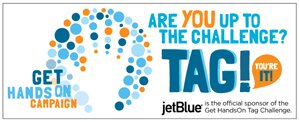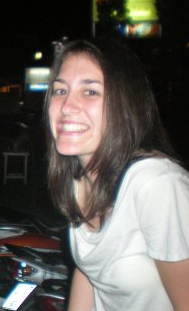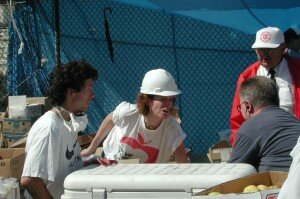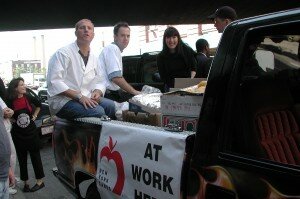 by , HandsOn Network
by , HandsOn Network
Today is the one year anniversary of one of our colleague’s death. I wrote this last year after her funeral, but wanted to share it here today so that her spirit might know that we are still thinking of her.
She didn’t show up for work, but I didn’t think anything of it.
I was surprised that she wasn’t there when I arrived because she usually beat me to the office, but I assumed she was traveling or working from home.
She was new, hired only a few weeks before. Though our desks were right next to eachothers, I didn’t know her very well yet.
When I learned she had been killed, one of our few conversations stood out.
She and I were talking about cooking and she said,
“My husband was raised to be a strong, black, southern woman, so you KNOW I eat well.”
I remember wondering what she meant.
In my memory of the conversation, I imagine myself tilting my head to the side like a confused cocker spaniel.
That is when she told me that her husband was transgendered.
I remember taking the information in, processing it, understanding.
I remember feeling pleased that she told me this so casually, like she trusted me.
I also remember worrying about her too. I hoped she would find acceptance in our workplace.
In the early afternoon of the day she didn’t come in, I learned that she died in a car accident on her way to work.
A beige sedan crossed oncoming, two-way traffic and caused an SUV to hit my colleague’s car head on.
The beige sedan sped away from the scene unharmed, but my colleague Errin died at the scene.
A group of us went to her funeral service where many of her friends and former colleagues shared stories and memories.
Almost everyone talked about the way Errin loved.
Her love, they said, was wide open, enormous and plentiful.
They said that she defended the weak and fought for social justice and equality, not with violence and anger, but with the mighty power of her humor, compassion and heart.
One storyteller recalled a time when Errin substituted for her as a childcare worker.
When the storyteller returned to the daycare center late in the day, she found Errin talking with the other teachers about her husband and the fact that he was transgendered.
“Aren’t you worried about what they might think?” the storyteller later asked Errin.
“Why would I be?” Errin replied with her signature laugh and gigantic smile. “I don’t want to be in a relationship with anyone who doesn’t accept the people I love.”
I left Errin’s service with a deep sense of loss.
I mourned not only her untimely death, but also my lost opportunity to know her well.
I also left understanding that when she told me about her husband, she wasn’t taking me into her confidence.
I admired her all the more for that.




 by ,
by , 
 Our family works to volunteer our time, money and support to the Diabetes cause as much as we can. We ask friends and family to support us as a family as we Walk for a Cure. And then we match the overall cash contribution we raise with our own funds. I also hand out fliers to my church group, my PTO and my bookclub.
Our family works to volunteer our time, money and support to the Diabetes cause as much as we can. We ask friends and family to support us as a family as we Walk for a Cure. And then we match the overall cash contribution we raise with our own funds. I also hand out fliers to my church group, my PTO and my bookclub.







 By, Meg Moloney, Senior Director, Programs,
By, Meg Moloney, Senior Director, Programs,  As my colleagues and I crossed the Williamsburg Bridge, we talked to each other and to total strangers, trying to make sense of events. It was a hot day. When we got to the Brooklyn side of the bridge, a small group of New Yorkers handed cups of water from the back of a pick-up truck to people trying to get home. This simple gesture brought relief to many and even tears to some. As I approached the impromptu aid station I remembered how 10 years before there had been serious racial tensions and violence not far from that spot. A lot had changed since 1991 and it was heartening to see residents from every part of the neighborhood working together to distribute water to the diverse and ragtag river of people walking by. Everyone seemed to feel a sense of togetherness about the experience. It made a world of difference to those of us with long walks still ahead and helped us put one foot in front of the other and keep going.
As my colleagues and I crossed the Williamsburg Bridge, we talked to each other and to total strangers, trying to make sense of events. It was a hot day. When we got to the Brooklyn side of the bridge, a small group of New Yorkers handed cups of water from the back of a pick-up truck to people trying to get home. This simple gesture brought relief to many and even tears to some. As I approached the impromptu aid station I remembered how 10 years before there had been serious racial tensions and violence not far from that spot. A lot had changed since 1991 and it was heartening to see residents from every part of the neighborhood working together to distribute water to the diverse and ragtag river of people walking by. Everyone seemed to feel a sense of togetherness about the experience. It made a world of difference to those of us with long walks still ahead and helped us put one foot in front of the other and keep going. Thousands of people came to us to volunteer—saying over and over that they wanted to find a way to do something positive in response to the tragedy. Many thousands of New Yorkers offered to help, as did people from California and Texas, and even Australia and Brazil.
Thousands of people came to us to volunteer—saying over and over that they wanted to find a way to do something positive in response to the tragedy. Many thousands of New Yorkers offered to help, as did people from California and Texas, and even Australia and Brazil. “Point Thank You”—a place just north of Ground Zero where volunteers let weary relief workers coming off their shifts know how grateful we were for their extraordinary efforts. In fact, it seemed everyone involved kept thanking each other—volunteers thanked first responders—first responders thanked volunteers. In the midst of unfathomable sadness, countless acts of generosity gave us strength.
“Point Thank You”—a place just north of Ground Zero where volunteers let weary relief workers coming off their shifts know how grateful we were for their extraordinary efforts. In fact, it seemed everyone involved kept thanking each other—volunteers thanked first responders—first responders thanked volunteers. In the midst of unfathomable sadness, countless acts of generosity gave us strength.




